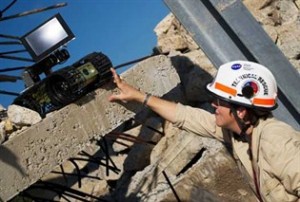The following is a guest blog post by Dr. Robin Murphy, Raytheon Professor of Computer Science and Engineering and Faculty Fellow for Innovation in High-Impact Learning Experiences at Texas A&M University.
The Nepal earthquake illustrates the need for critical real-time computing and information systems, dubbed “CRICIS computing” by a 2012 NSF/CCC visioning workshop. The findings from the CRICIS report still hold: that disasters require “fundamental new research in socio-technical systems that enable decision-making for extreme scales under extreme conditions. This research cuts across physical and engineered artifacts, information technology, and human-computer collaboration. It is an example of the general shift in science and industry from physical devices and computational packages to socio-technical information systems used by a diverse population. CRICIS consists of five themes of cross-disciplinary research: integrating computing, physical science, and social science; working and comprehending at scale; real-time awareness and modeling; methods and metrics; and training and education.”
The use of crowd sourcing, small unmanned aerial systems, smart phones, and other discrete information technologies that we are seeing at Nepal is wonderful, but is not a silver bullet. These technologies currently produce data that is often unusable because it is ad hoc in content, location, and delivery. Indeed the sheer volume of data overwhelms wireless networks. Better networks can increase the ability to deliver the data, but it still needs to be prioritized and visualized so that the different stakeholders get the right data at the right time in the right form to make a rapid, meaningful decision.
As just one example of the need for a pervasive CRICIS computing approach, consider the challenges that my colleague, Dr. Shinichi Egawa at the International Research Institute for Disaster Science (IRIDeS) at Tohoku University, witnessed during the 2011 Tohoku earthquake and tsunami. The first large-scale decision was whether a particular hospital (or portions) was currently safe and if safe, whether it was vulnerable to after shocks. As with Nepal, hospital personnel in Japan had to decide whether to evacuate patients, risking immediate death or decreased survival rates due to the process of moving, or to expose them to possible death from an aftershock. Worse yet, as seen at Nepal, there may be no place to house patients in the extreme cold so standing structures become overcrowded and unsanitary.
However, hospital personnel are not structural engineers. Even if they can take photos of cracks and have a network by which to transmit them to engineers off-site, many cracks are not visible. Besides, just seeing a crack isn’t enough, the decision depends on access to prior knowledge about the type of construction, history of past earthquakes, soil—in order to make a decision.
Continuing on with the hospital example, Nepal reported over 14,000 injured citizens whereas Japan reported just over 6,000. Japanese hospital personnel wanted information technology to understand what is going on outside their building. Are large numbers of injured beginning to congregate outside? Is there significant activity in surrounding areas that suggests there are heavy casualties? At the larger regional or country-wide scale, information as to Which hospitals are operational? Which are overrun? and Which have empty beds and supplies? is critical to optimizing life-saving resources. One possible solution is for each hospital to have an aerostat, or stationary blimp, to provide the “eye in the sky” view and double as an emergency cell tower, re-establishing connectivity. But this solution masks the hidden need for data structures and programs that would allow the hospitals to securely share information about their state with each other, while preserving patient privacy. And an informatics solution for a consortium of hospitals may not guarantee that other facets of the response could contribute or share information. For example, search and rescue teams in the field would not normally be included in designs of hospital-to-hospital communication and thus they might not be able provide the information they are collecting about victims in the field.
The intensity of the Nepal earthquake illustrates a more subtle challenge in informatics: human-computer integration in adverse environments. As noted in the CRICIS report “[CRICIS] is about enhancing human capabilities in making decisions for extreme events that challenge comprehension under extreme situations during which decision makers are tired, dirty, and hungry; they may be working remotely and under dangerous, uncomfortable, demanding conditions that are physiologically and cognitively disrupting. Research is needed in sensemaking, comprehension, visualization, trustworthy data, decision support tools, and determining physiological and cognitive impacts.”
In conclusion, CRICIS is an emerging area of research not covered by other programs. It can leverage advances in CPS, BIGDATA, and Hazards SEES but is unique. Like health care research, CRICIS has to consider digital and non-digital sources of information and how stakeholders make decisions. Unlike health care, CRICIS has to consider how the physical scale and damage of the disaster impacts the socio-technical system, especially gathering data and working remotely.
I encourage you to read the CRICIS report and push for its recommendations for long-term research investments to foster a new community whose work will save lives and accelerate economic recovery.










